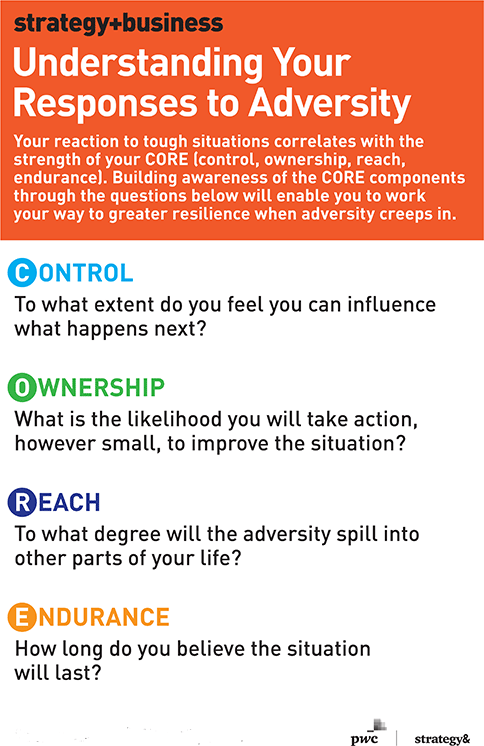Build your leadership resilience. It’s an act of defiance.
To develop the skills you’ll need to respond to adversity with strength, follow these three steps.
Resilience is a personal act of defiance. A moment of resilience is your chance to face adversity and say: “No, not today. You will not stop my momentum or reduce my potential to make the most of this opportunity.”
Unfortunately, for many leaders besieged by the constant change, rising ambiguity, and intensifying complexity of today’s business world, it is adversity — a big or small problem rising from your experience — that does most of the talking: “Yes, I will change your plans. I will undo your progress. I will cause you to question your goals and I’ll be sure to mess with your confidence along the way.”
The good news is that resilience — the way in which you respond to life’s challenges — is a skill that can be developed through intentional observation and practice. So if you’re ready to change the script and take control of your inner dialogue, you can implement these three strategies to respond more powerfully to any adversity:
Work your plan. You cannot overvalue your own resilience. It affects everything about you, from your capacity to solve problems and innovate to your physical, mental, and emotional well-being. Resilience is like a super-competency, influencing many other related skills and abilities that you need to deploy in order to work, manage, and lead well.
Once you’ve internalized the significance of building and maintaining your own resilience, it’s important to have a plan to manifest it and to work your plan consistently.
There are a variety of frameworks to help you understand the nature of adversity and your response to it. Among the more compelling models is Adversity Quotient, which is backed by decades of research. Developed by Paul G. Stoltz, Ph.D., this model measures your resilience according to the strength of your CORE (control, ownership, reach, endurance).
Control is the extent to which you believe you can influence whatever happens next. Ownership is the likelihood that you will actually do something, however small, to improve the situation. Reach is the degree to which adversity will spill into other aspects of your life (work affecting home or home affecting work, for example). And endurance is the length of time you perceive the situation will last.
To build and work your plan for greater resilience, strengthen your CORE.
Start by noticing your response from the moment adversity appears. Work through each of the four dimensions, one by one, to make sure you don’t lose your ability to make the situation better.
Win the inner game. Tim Gallwey, a leadership expert and executive coach, developed the concept of the “inner game” in his work with athletes and leaders across professions. He recognized that performance was overwhelmingly influenced by how people managed their mind-sets in the critical moments of action.
All leaders play the inner game, a tug-of-war between the constructive and destructive thoughts, attitudes, and beliefs that subtly — but powerfully — shape their behaviors and ultimately their performance. Adversity is one of the most dominants forces in this game.
For example, when your mind-set produces noise (e.g., self-doubt, limiting beliefs, lapses in focus, and flashes of fear), it interferes with your conscious decision making. To play the inner game well, you have to quiet the noise and reduce the interference to regain your focus and restore the integrity of your inner dialogue, which leads to better actions.
But when adversity elevates your urgency and confusion, interference from your anxious brain can quickly sabotage whatever you are trying to accomplish. Consider this example from one of my coaching clients, a senior leader and sought-after subject-matter expert in her field:
“I walked into the room, immediately maneuvered away from the head of the table, and seated myself in the chair farthest from where the CFO would sit. I didn’t think about it; I just unconsciously did it. Once I sat down, I instantly regretted my choice. The negative thoughts flowed fast. I figured I had just undermined my credibility and — because I was supposed to be leading the meeting — I wondered if I would regain the confidence that was obviously faltering.”
Some adversity we encounter through no fault of our own. It just finds us and reminds us of how little control we have over the events and circumstances that surround us. Other forms of adversity are homegrown. Call them unforced errors or self-inflicted challenges. This was the case for my client when she withdrew herself from her meeting by taking a less prominent seat at the table.
The good news is that resilience — the way in which you respond to life’s challenges — is a skill that can be developed.
But as the inner game played out, she found a way to quickly quiet the noise and reduce its interference between her wavering confidence and her desire to establish herself as a trusted advisor in the room. What she did next, in response to adversity, was her own small act of defiance.
“I sat up straight, resting my arms gently on the table. I relaxed my face and subtly eased the tension out of my neck and shoulders. And I made sure that the first words I spoke projected my voice firmly. I did not let anyone in the room catch a glimpse of the swirling doubts in my mind.”
Making small but laser-focused moves like this can quiet the noise and contain the adversity — and that’s how you win the inner game.
Leverage every micro-adversity. The big ones often grab the spotlight. Our company was just sold. Our competitor landed the client. A close colleague was diagnosed with a serious illness.
Although these major adversities have the potential to reshape the landscape of a life, they aren’t necessarily the best starting point to build resilience. The better strategy is to leverage everyday micro-adversities to steadily increase your resilience and place yourself in a stronger position to respond when the big one shows up.
I shared an idea during a conference call but it didn’t get the response I wanted. My boss just assigned me a project that I’m not excited about. I tried to give a colleague some feedback, but it backfired and now there’s tension between us.
These are examples of micro-adversities. They’re not a big deal — except for the fact that they kind of are. Without a strong CORE, micro-adversities can weigh on your mind, making you feel powerless or stuck and tilting the inner game out of your favor by stealing attention from other important matters.
However, if you proactively leverage each micro-adversity to strengthen your CORE, you gain the ability to not only lead yourself through any adversity you encounter, but to lead others to do the same. The goal is not to be an impenetrable, rock-solid force that is immune to the threats of adversity. Rather, it is to be 1 percent more resilient tomorrow than you are today.
So what will your next act of defiance be?







